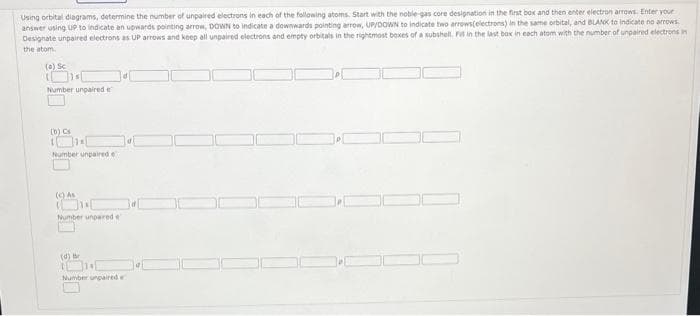Using orbital diagrams, determine the number of unpaired electrons in each of the following atoms. Start with the noble-gas core designation in the first box and then enter electron arrows. Enter your answer using UP to indicate an upwards pointing arrow, DOWN to indicate a downwards pointing arrow, UP/DOWN to indicate two arrows(electrons) in the same orbital, and BLANK to indicate no arrows. Designate unpaired electrons as UP arrows and keep all unpaired electrons and empty orbitals in the rightmost boxes of a subshell. Fid in the last box in each atom with the number of unpaired electrons in the atom (a) Sc Number unpaired e (b) Cs Number unpaired e (c) As 10 Number unpared e (0) D Number unpaired e
Using orbital diagrams, determine the number of unpaired electrons in each of the following atoms. Start with the noble-gas core designation in the first box and then enter electron arrows. Enter your answer using UP to indicate an upwards pointing arrow, DOWN to indicate a downwards pointing arrow, UP/DOWN to indicate two arrows(electrons) in the same orbital, and BLANK to indicate no arrows. Designate unpaired electrons as UP arrows and keep all unpaired electrons and empty orbitals in the rightmost boxes of a subshell. Fid in the last box in each atom with the number of unpaired electrons in the atom (a) Sc Number unpaired e (b) Cs Number unpaired e (c) As 10 Number unpared e (0) D Number unpaired e
Introductory Chemistry: A Foundation
9th Edition
ISBN:9781337399425
Author:Steven S. Zumdahl, Donald J. DeCoste
Publisher:Steven S. Zumdahl, Donald J. DeCoste
Chapter11: Modern Atomic Theory
Section: Chapter Questions
Problem 55QAP
Related questions
Question
Give typed explanation of all subparts not a single word hand written otherwise leave it

Transcribed Image Text:Using orbital diagrams, determine the number of unpaired electrons in each of the following atoms. Start with the noble-gas core designation in the first box and then enter electron arrows. Enter your
answer using UP to indicate an upwards pointing arrow, DOWN to indicate a downwards pointing arrow, UP/DOWN to indicate two arrows(electrons) in the same orbital, and BLANK to indicate no arrows.
Designate unpaired electrons as UP arrows and keep all unpaired electrons and empty orbitals in the rightmost boxes of a subshell. Fil in the last box in each atom with the number of unpaired electrons in
the atom
(a) Sc
Number unpaired e
(b) Cs
Number unpaired e
(c) As
Number unpared e
(d) B
1
314
Number unpaired
Expert Solution
This question has been solved!
Explore an expertly crafted, step-by-step solution for a thorough understanding of key concepts.
This is a popular solution!
Trending now
This is a popular solution!
Step by step
Solved in 2 steps with 1 images

Knowledge Booster
Learn more about
Need a deep-dive on the concept behind this application? Look no further. Learn more about this topic, chemistry and related others by exploring similar questions and additional content below.Recommended textbooks for you

Introductory Chemistry: A Foundation
Chemistry
ISBN:
9781337399425
Author:
Steven S. Zumdahl, Donald J. DeCoste
Publisher:
Cengage Learning

Chemistry & Chemical Reactivity
Chemistry
ISBN:
9781337399074
Author:
John C. Kotz, Paul M. Treichel, John Townsend, David Treichel
Publisher:
Cengage Learning

Chemistry & Chemical Reactivity
Chemistry
ISBN:
9781133949640
Author:
John C. Kotz, Paul M. Treichel, John Townsend, David Treichel
Publisher:
Cengage Learning

Introductory Chemistry: A Foundation
Chemistry
ISBN:
9781337399425
Author:
Steven S. Zumdahl, Donald J. DeCoste
Publisher:
Cengage Learning

Chemistry & Chemical Reactivity
Chemistry
ISBN:
9781337399074
Author:
John C. Kotz, Paul M. Treichel, John Townsend, David Treichel
Publisher:
Cengage Learning

Chemistry & Chemical Reactivity
Chemistry
ISBN:
9781133949640
Author:
John C. Kotz, Paul M. Treichel, John Townsend, David Treichel
Publisher:
Cengage Learning


Chemistry
Chemistry
ISBN:
9781305957404
Author:
Steven S. Zumdahl, Susan A. Zumdahl, Donald J. DeCoste
Publisher:
Cengage Learning

Chemistry: An Atoms First Approach
Chemistry
ISBN:
9781305079243
Author:
Steven S. Zumdahl, Susan A. Zumdahl
Publisher:
Cengage Learning